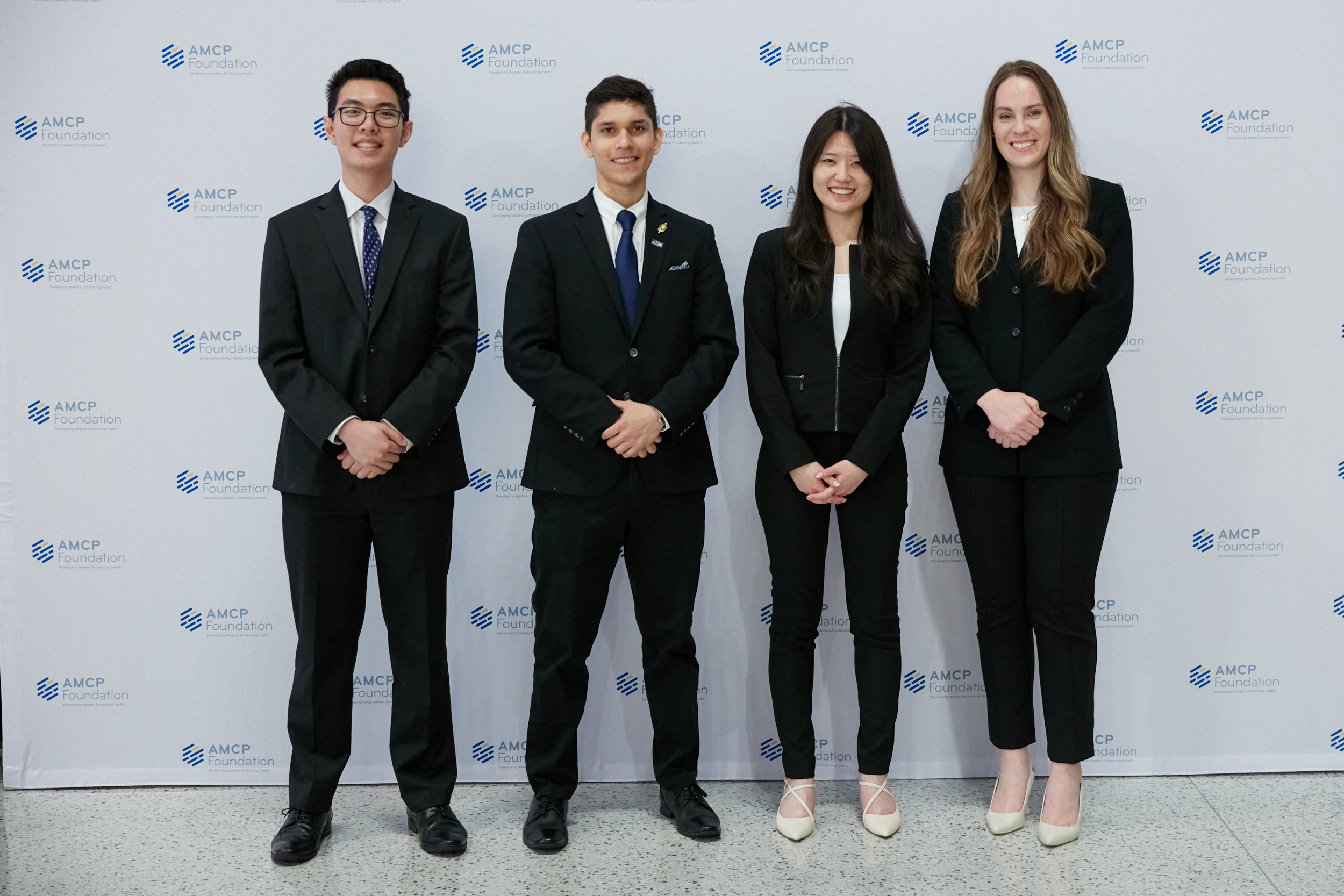Rituals are part of the human condition, yet some push the envelope to surprising extremes. Why people engage in highly painful, even dangerous, ritual behaviors is a question UConn researcher Dimitrios Xygalatas is exploring in societies from southern Europe to the island nation of Mauritius in the Indian Ocean.
Xygalatas, an assistant professor of anthropology and director of UConn’s experimental anthropology lab, has lived as an ethnographer among villagers who practice fire walking in Spain and Greece, and with the inhabitants of Mauritius who subject themselves to extreme body piercing and mutilation in celebration of Thaipusam, a Hindu religious festival.
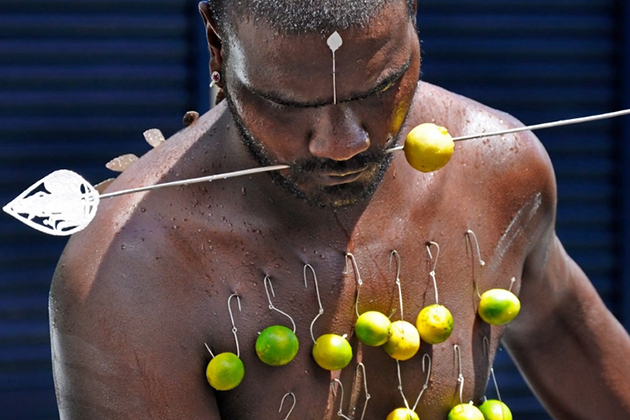
To an outsider, these behaviors are a mystery. And that’s precisely what inspired Xygalatas to learn more.
“I was always fascinated by extreme, high intensity rituals, because they are so puzzling,” he says. “I asked myself why do people engage in these really painful or dysphoric or even dangerous activities. For as long as we have studied human civilization, societies have performed rituals which at first sight don’t really seem to have a function, and yet they are passed down from generation to generation.”
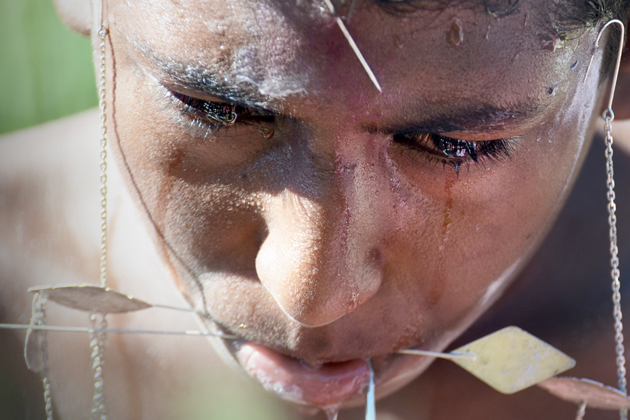
Rituals are not the same as superstitions, he notes. Whereas a superstition implies the existence of a belief system, rituals evolve more spontaneously. People don’t always think about why they engage in ritual behavior, other than admitting that it makes them feel good, especially when it is done collectively. With no centralized doctrine, there may be a leader present, but this role is primarily confined to seeing that the ritual procedures get performed properly, and doesn’t involve teaching or instruction.
“When I have asked people why they take part in fire walking or in body piercings, I get all sorts of answers,” he says, “but the most common is, ‘We don’t know, we just do it because we’ve always done it this way. That’s what our tradition is all about.’”
What effect then, do these rituals have upon those who practice them?
Fire walking
In the village of San Pedro Manrique in Spain, Xygalatas and his fellow researchers used heart rate monitors on performers and spectators at a fire walking ceremony to record levels of physiological arousal.
“We chose this ceremony because the people who fire walk there do so one after another, not in synchrony, says Xygalatas. “This allowed us to separate the effects of ritual structure itself from the effects of synchronous movements, which are known to produce interpersonal rapport. We also had observers present, both from the village and from outside the community. We wanted to find out what happens when people share an experience.”
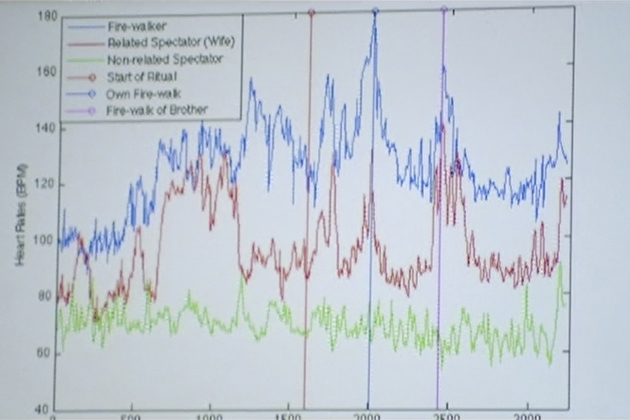
The results revealed that heart rates of the fire walkers and their relatives and friends from the village rose and fell almost in unison before, during, and after the ceremony. The heart rates of visiting spectators did not. This lent credence to the observation of Xygalatas and others that ritual experiences serve to develop strong emotional bonds among participants and those who are closest to them.
“The synchrony effect was so strong,” he says, “that we were actually able to predict people’s social proximity based on the level of physiological arousal, and vice versa.”
Rituals involving piercings and more
In an effort to examine behavioral as well as physical manifestations, Xygalatas and his team conducted a different experiment on Mauritius during the Thaipusam. Watch a video of Xygalatas at work during the festival.

While almost everyone celebrates the festival, the degree to which they do so varies from relatively passive behavior such as engaging in collective prayer or support roles such as walking in the procession, to extreme body piercing that may include needles run through their tongues or broomstick-size skewers perforating their cheeks, and more.
Some festival participants choose to walk barefoot five or more hours in the tropical sun while carrying heavy bamboo canopies called kavadi, which means ‘yoke’ or ‘burden’ in Hindi. Others drag chariots the size of small cars and weighing several hundred pounds by chains attached to hooks through their skin. When they arrive at the temple of Murugan, celebrants climb 242 steep steps to deliver their offerings to the deity.
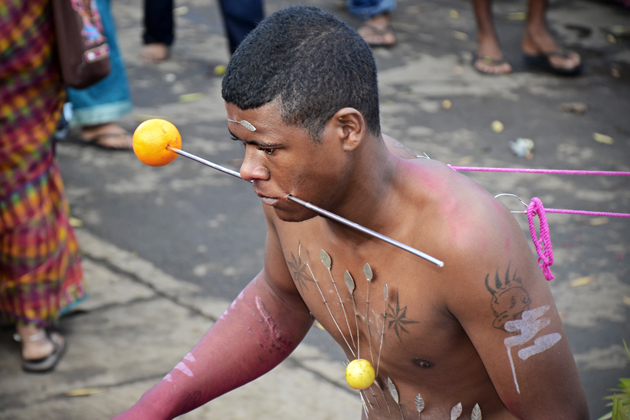
In Xygalatas’ study, all participants were offered 10 coins worth 20 rupees each – roughly a couple of days’ wages for an unskilled worker – if they would complete a survey about their experience at the festival. Once they had received their compensation, they were asked if they would like to make a donation to a charity. Although replies were anonymous, the experimental design allowed researchers to connect individual donations to survey responses.
“What we saw is what we had predicted,” Xygalatas says. “Those who performed high intensity rituals, as well as their families and friends who observed them, gave over twice as much as those who performed a low arousal ritual. They, in turn, gave more than those who performed no ritual. When we asked high arousal participants how intense the pain was, we saw a direct correlation between how painful the ritual experience was and how much they donated.”
While studies continue, these results support the hypothesis that pain resulting from voluntary ritual participation creates communal bonds. Whether the response to painful stimuli by those most affected is somehow tied to altruism hasn’t been determined. However, a clue from neuroscience suggests that as rituals become more arousing, they may trigger hormones that stimulate reward systems in the brain, thus transforming what initially may be a painful experience into a pleasurable one. This, in turn, may be what triggers other behaviors such as charity or feelings of community.
Combining field work with lab science
As an experimental anthropologist trained in both ethnographic and experimental methods, Xygalatas combines traditional field work with laboratory science as he studies ritual behaviors in their natural contexts.
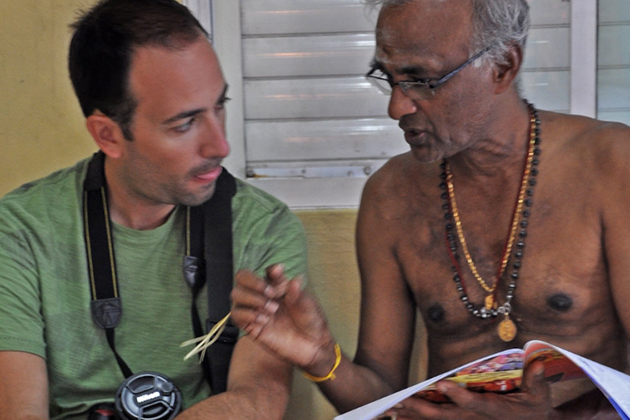
“Rather than taking subjects out of context and moving them to a sterilized laboratory setting, we take our laboratory into the field so that we can observe people in their natural surroundings,” he says.
Prior to joining UConn last fall, Xygalatas had been with the universities of Princeton, Aarhus (Denmark), and Masaryk (Czech Republic), where he served as director of the Laboratory for the Experimental Research of Religion.
“I came to UConn,” he says, “because this is one of the best departments of anthropology in the world for someone who is interested in applying scientific methods to the study of culture. There’s a very long tradition of cognitive and evolutionary anthropology here, including pioneering work by [emeritus professor and former department head] Roy D’Andrade, James Boster, and Penn Handwerker, who have made some of the most important contributions in the field of cognitive anthropology, as well as Richard Sosis, who is one of the top human behavioral ecologists working on religion.”

